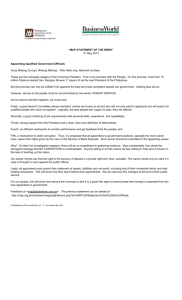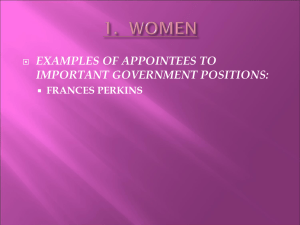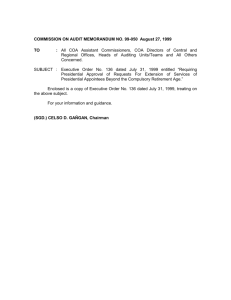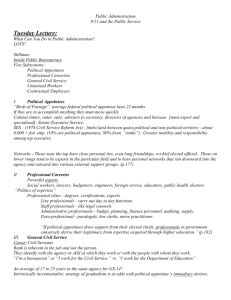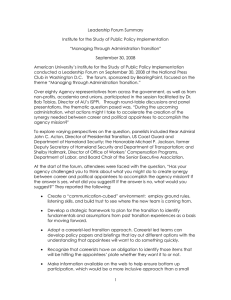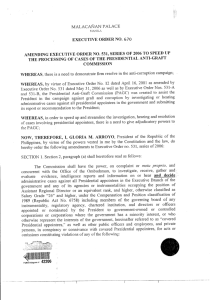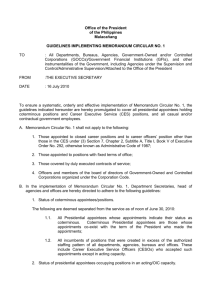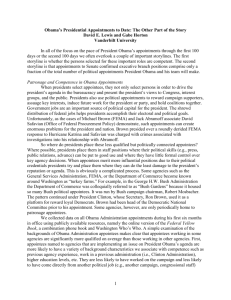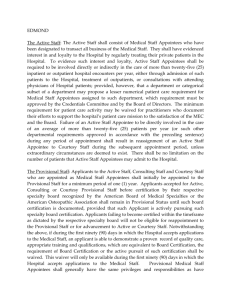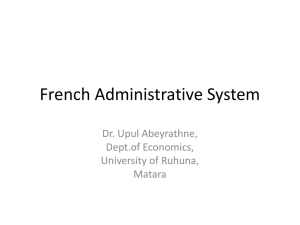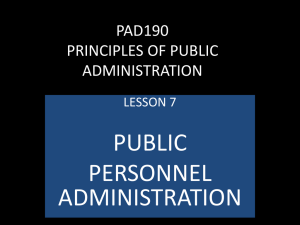PowerPoint Seven (Policy Players and Processes -
advertisement
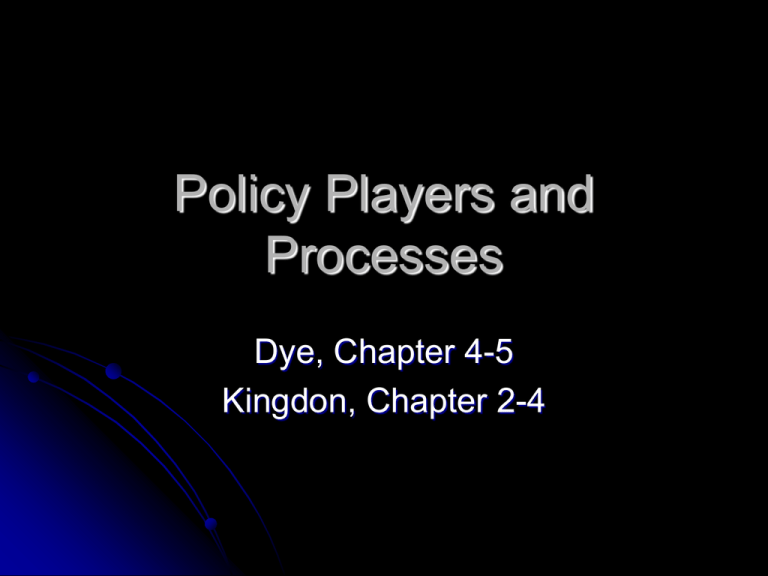
Policy Players and Processes Dye, Chapter 4-5 Kingdon, Chapter 2-4 President President can affect the course of Health Care Policy by: Influencing the Agenda President is considered “very or somewhat important” by ¾ and “very important” by 31% in a study by Kingdon Using Institutional Resources Veto Hire and Fire President Using Organizational Resources Executive Branch is a “unitary decision making entity” in contrast to the Legislative or Judicial Branches Using Public Attention Public opinion puts pressure on the other branches to carry out the President’s agenda Being Involved Involvement beyond the basics, including phone calls, repeated requests, and letters Presidential Staff Includes the staff in the White House and in the Executive Office top personal advisors of the President members of Executive Office agencies, such as the Domestic Policy Staff, Council of Economic Advisors, and the OMB. Plays a very important role in agenda setting. Presidential Staff Agenda Setting In the distinction between the agenda and the alternatives, the presidential staff usually deals with the alternatives. The President makes up the agenda, makes the very important decision and then sets the tone for the Presidential Staff to follow. The Presidential Staff deals with the detailed negotiation of the issue with the departments, Capitol Hill, and major interests groups. Produces the administration’s proposals and clarifies the bargaining positions of the administration, then sends proposals to the legislative process. Political Appointees Role on Policy Making Appointed by President; part of the Administration; appointees range from cabinet secretaries to head of bureaus or administrations. Seen by public as equally important to President (82% of a study believed that political appointees are very to somewhat important; 26% believed they were very important to the political process.) Political appointees play a key role in placing ideas on the agenda: They often elevate issues rather than creating them. Political Appointees Downfalls Political appointees should be critical policy makers, however, political appointees may become captured by their agencies or professional civil servants find ways to circumvent their appointed superiors. Political appointees have a short length of service time, which can lead to more rapidly made decisions, resulting in good and bad. The president’s priorities usually set the policy agenda for appointees although appointees may sometimes try to persuade an issue to the president. Political Appointees Examples Kingdon: 1979 – top level appointees in Dept. of Health, Education, and Welfare (p.28) Appointees can push an old agenda that may be supported by President to help take welfare recipients that are persistently poor off of welfare. American Association of Retired Persons (AARP) may push an appointee toward their decisions to uphold and increase Social Security or Medicare. Civil Servants Civil Servants Are specialists in a particular area of policy Do not actually set policy agendas but generate feedback from agendas Two types of bureaucrats Line: Concentrates on administering existing programs Staff: Deliberate on researching policy changes Civil Servants Continually working on proposals till administration is receptive Depends upon: President Congress Political Appointees Internal Struggle: When deadlocked, may leak information Release premature proposals Civil Servants Civil Servants are important to policy because: Longevity: wait till they have a receptive administration Expertise: they have experience from the past Iron Triangle: bureaucrats, committees, interest groups Interest Groups Types of Interest Groups Business and Industry Professional Labor Public Interest Groups Governmental Officials as Lobbyist Interest Groups Types of Interest Group Activity Some affects the agenda Other activity affects the alternatives considered by policy makers Some is positive, promoting new courses of government action Other activity is negative, seeking to block changes in public policy Interest Groups Interest Group Resources Their geographical dispersion in congressional districts throughout the country Their ability to mobilize their members and sympathizers Their status or wealth are thought to have an ability to affect election outcomes Media Includes Reporters Columnists, Anchors, Editors in TV, Newspapers, Magazines, Internet Often misrepresent their own opinions as public opinions, like an elite group Media On the Agenda: Major influence on agenda setting: issues it reports on will receive attention from citizens and politicians Kingdon: Media has less influence on agenda settingmay indirectly affect public opinion but policy-makers have usually decided if an issue will be on the agenda or not by the time the media reports on it Main source of information on public policy issues Tend to take a liberal stance on issues and to sensationalize/dramatize them Can influence viewers’ opinions on new issues but not as likely to change established opinions on old issues Media Health Care: Media groups would advocate health care reform, a national health care system or universal care, increased spending on Medicare and Medicaid, more services to be provided by this programs, and availability to more people (liberal views) The media would call attention to cases of extreme poverty and suffering, appealing to viewer’s emotions and possibly misrepresenting the problem, focusing on the failures of Medicaid and Medicare and not the successes Wilson: Media would empathize w/ the working class and would depict the average hard-working American who may not receive adequate health coverage Also would publicize statistics and figures such as the U.S.’s high level of health care spending compared to our low life expectancy. Again, the facts could be distorted. For example, the media would probably use definitions of poverty that encompass a greater proportion of the population than the accepted 12.7% Media Health Care (cont.) Media reports would not use technical terms or be too hard to understand, they would likely use catch phrases and expressions which the public would pick up on but may not really understand. For example, the average American may not know the difference between the various government assistance programs If enough attention is given to health care by the media, public concern for it will rise and politicians will be more likely to include it on policy-making agendas.
